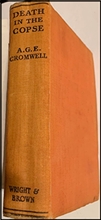Sat 12 Mar 2022
A PI Mystery Review: A. G. E. CROMWELL – Death in the Copse.
Posted by Steve under Reviews[5] Comments
A. G. E. CROMWELL – Death in the Copse. Rodney Wayne #2. Wright & Brown, UK, hardcover, 1940.

This is the second of just two private detective novels written by the almost entirely unknown A. G. E. Cromwell, the first adventure of Rodney Wayne being Murder in Flat 14 (Wright & Brown, 1939). The two books can be found on the Internet at varying prices, but as for the author himself, I have found only a single reference to him, that being an announcement for one of his books in a contemporaneous Australian newspaper. (If you can find more, please by all means, let me know.)
Wayne eventually has a client in Death in the Copse, but at the beginning, he’s only on his way to a weekend stay at a good friend’s countryside mansion, a short train ride from London. The friend is Archie Crofts, a good-natured, self-made but very wealthy businessman. Besides the staff, there is a small groups of other friends also staying for the weekend, so when Archie is found shot to death at night in a small area of a forest, the number of suspects is also very limited. (The killer is seen running back to the house after the fatal shot is heard, so there is no talk of a passing tramp being responsible.)
Wayne finds himself somewhat at odds with the local police inspector, at least at first, but when Wayne decides he won’t get anywhere by going head to head with him, he persuades himself to join forces with him. There is a lot of discussion of alibis between the two of them, including the strange behavior of one possible witness who has to have an alibi for another twisted out of him instead of his being up front and forward about it. We have probably read enough mysteries ourselves to know what that means, don’t we?
Cromwell himself clearly had read enough works of detective himself to be able to produce a quite decent and very readable one on his own. Until the last chapter, that is, which is, to put it bluntly, a disappointment. Once you put the book down and you start asking yourself, in terms of the figuring out what really did happen, why does the final explanation almost completely contradict what we told was observed earlier?
An interesting artifact of its day, but not one, I’d say, worth searching out for. (I’d send you mine, but unfortunately it has a page missing from the end of a chapter somewhere in the middle. By no means is it an essential one, but it *is* missing.)
March 12th, 2022 at 8:57 pm
There is no shortage of private eyes in British fiction from Martin Hewett on, but few fall in the hard-boiled tradition. Quite a few are more or less thriller characters (Frank King’s the Dormouse, Hugh Cleveley’s Maxwell Archer, even Wyndam Martyn’s Anthony Trent briefly) though in the thirties you start to get writers like Cheyney, David Hume, and E.B. Quinn and by the post war era the likes of John Bentley’s Dick Marlow and Gerard Fairlie’s Johnny McCall.
But there is no shortage of private eyes in the mystery novels of Eden Phillipotts, John Ferguson, and a few others, just not the hard-boiled variety.
March 12th, 2022 at 9:47 pm
I’ve sampled the adventures of most of the British PI’s you mention, David, and you’re right, none of them are made of the same cloth as their American counterparts. On a hardboiled scale ranging from 1 to 10, Rodney Wayne would be ranked a zero. That doesn’t mean that this one wasn’t fun to read, because it was. With a little bit of work rewriting the last chapter, this one might have been a contender.
March 18th, 2022 at 3:32 pm
Steve, is it A.G.E. Cromwell rather than A.G.F. Cromwell?
March 18th, 2022 at 4:54 pm
Jamie, You are correct to ask. It is indeed A.G.E. I really messed up on that. Luckily I can fix it right away. Thanks!
October 10th, 2022 at 10:03 pm
Steve I just go the book myself actually a quite nice copy in Dust jacket. How did you get the 1940 date? Did it have it on the copyright page? My copy doesn’t. Let me know if it does.
I am looking at it tonight and I was going to check the english catalog of books for the Date and the fact that the DJ is 2/6 price. In general british firsts are more than 2/6 except for publishers like Philip Allan. It does say the 2/6 series on the back panel.